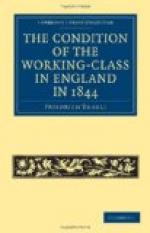Typhus, that universally diffused affliction, is
attributed by the official report on the sanitary condition
of the working-class, directly to the bad state of
the dwellings in the matters of ventilation, drainage,
and cleanliness. This report, compiled, it must
not be forgotten, by the leading physicians of England
from the testimony of other physicians, asserts that
a single ill-ventilated court, a single blind alley
without drainage, is enough to engender fever, and
usually does engender it, especially if the inhabitants
are greatly crowded. This fever has the same
character almost everywhere, and develops in nearly
every case into specific typhus. It is to be
found in the working-people’s quarters of all
great towns and cities, and in single ill-built, ill-kept
streets of smaller places, though it naturally seeks
out single victims in better districts also.
In London it has now prevailed for a considerable
time; its extraordinary violence in the year 1837
gave rise to the report already referred to.
According to the annual report of Dr. Southwood Smith
on the London Fever Hospital, the number of patients
in 1843 was 1,462, or 418 more than in any previous
year. In the damp, dirty regions of the north,
south, and east districts of London, this disease
raged with extraordinary violence. Many of the
patients were working-people from the country, who
had endured the severest privation while migrating,
and, after their arrival, had slept hungry and half-naked
in the streets, and so fallen victims to the fever.
These people were brought into the hospital in such
a state of weakness, that unusual quantities of wine,
cognac, and preparations of ammonia and other stimulants
were required for their treatment; 16.5 per cent. of
all patients died. This malignant fever is to
be found in Manchester; in the worst quarters of the
Old Town, Ancoats, Little Ireland, etc., it is
rarely extinct; though here, as in the English
towns generally, it prevails to a less extent than
might be expected. In Scotland and Ireland,
on the other hand, it rages with a violence that surpasses
all conception. In Edinburgh and Glasgow it
broke out in 1817, after the famine, and in 1826 and
1837 with especial violence, after the commercial
crisis, subsiding somewhat each time after having raged
about three years. In Edinburgh about 6,000
persons were attacked by the fever during the epidemic
of 1817, and about 10,000 in that of 1837, and not
only the number of persons attacked but the violence
of the disease increased with each repetition. {100a}
But the fury of the epidemic in all former periods seems to have been child’s play in comparison with its ravages after the crisis of 1842. One-sixth of the whole indigent population of Scotland was seized by the fever, and the infection was carried by wandering beggars with fearful rapidity from one locality to another. It did not reach the middle and upper classes of the population, yet in two months there




